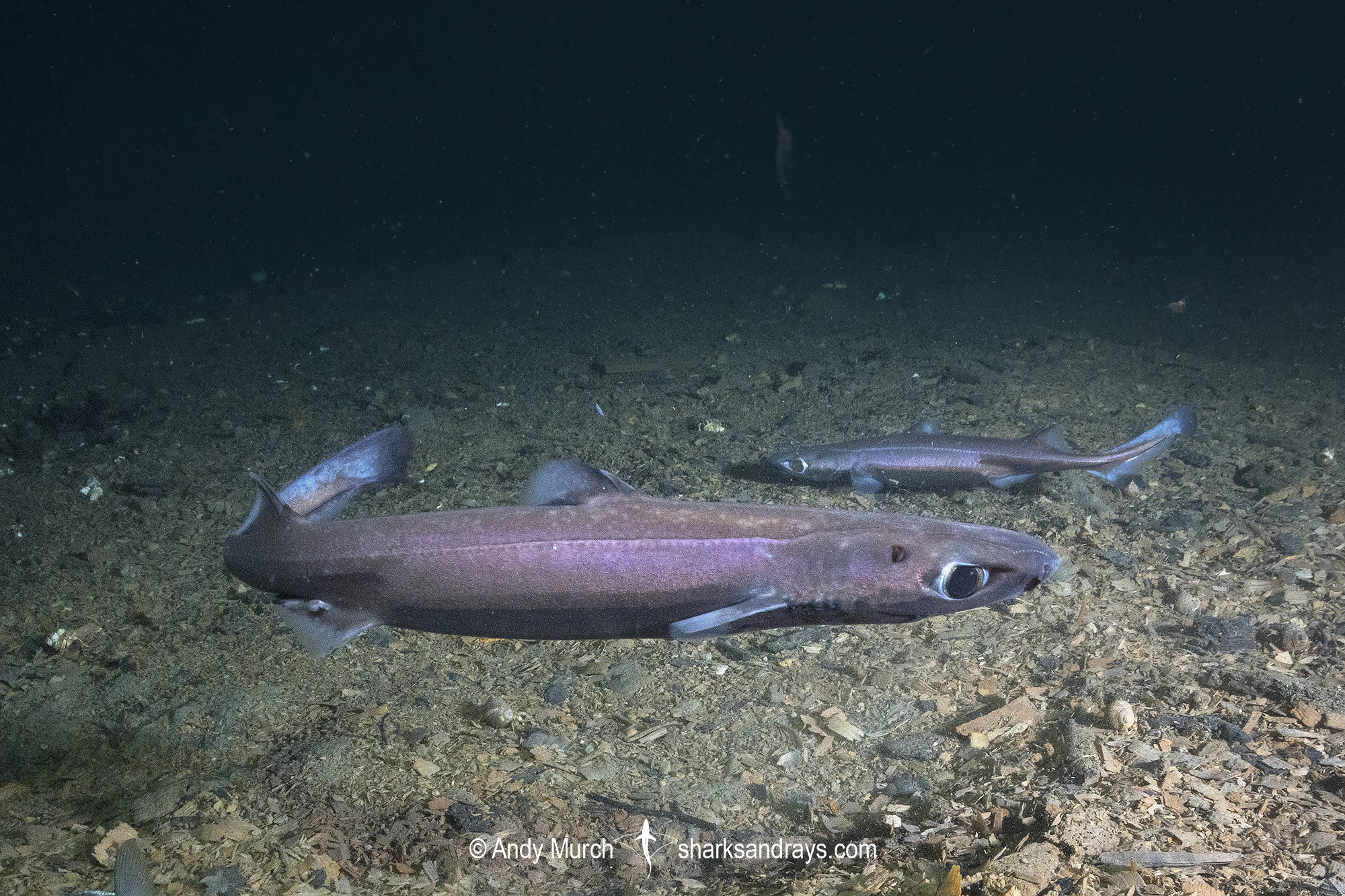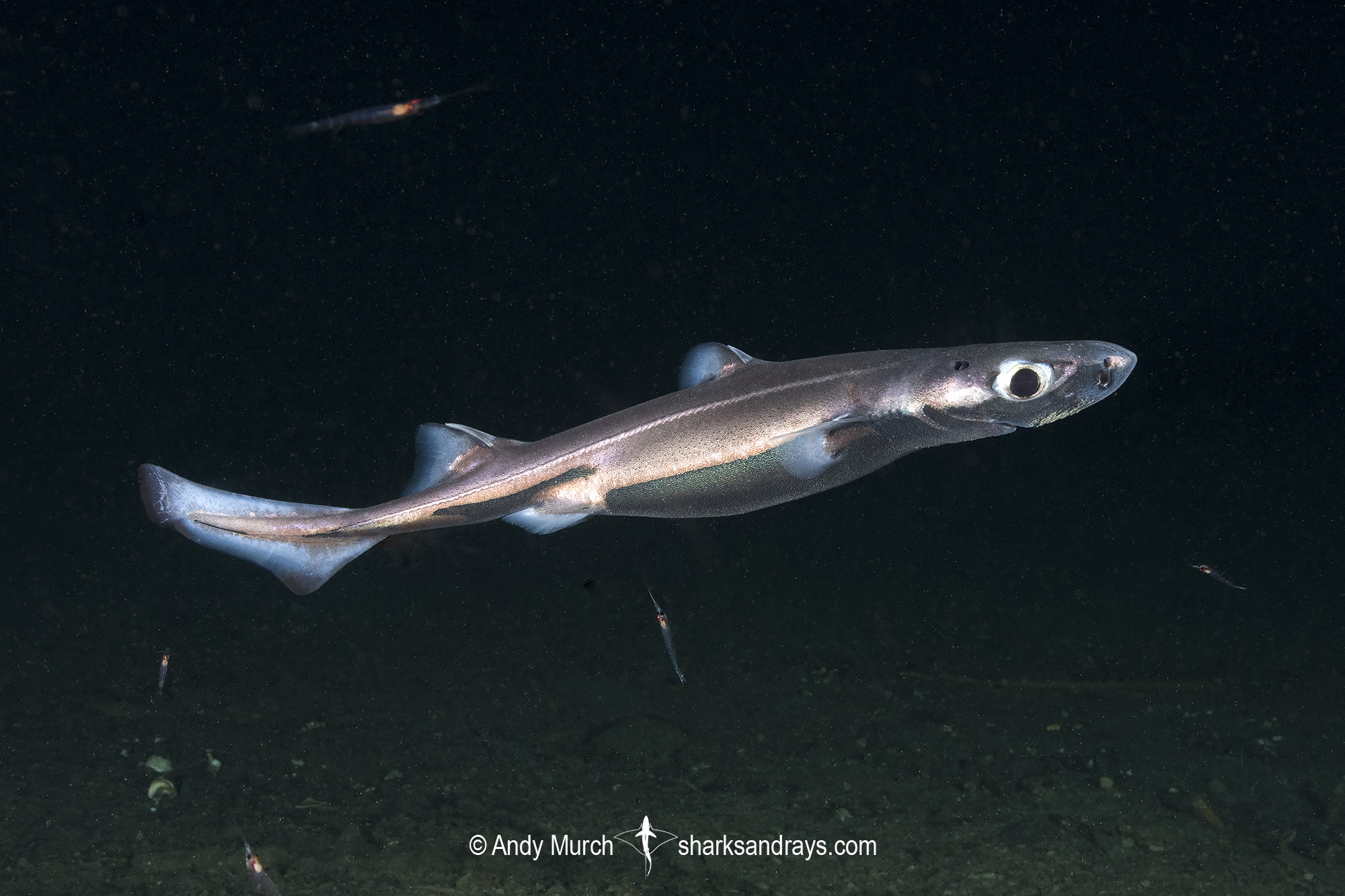Common name(s)
Velvet Belly Lanternshark.
Identification
A small shark species with a long, bluntly rounded snout, large green-reflective eyes, and five very short gill slits. First dorsal fin small and low, with a rounded apex and an anterior fin spine that is equal to or less than half the length of the anterior dorsal margin. First dorsal origin slightly posterior to free rear tip of pectoral fins. Second dorsal approximately 2x height of first dorsal, with a pointed apex, a concave posterior margin, and a curved second dorsal fin spine that is approximately 2/3 length of second dorsal anterior fin margin. Pectoral fins small with rounded apexes and short rounded free rear tips. Pelvic fin low. No anal fin.
Dorsal coloration reddish brown or dark brown. Ventral surface covered in black photophores. Photophores may appear green under artificial lights. All fins pale near their bases, fading to black near the margins.
Size
Maximum recorded size 60cm but this species rarely exceeds 45cm.
Habitat
Temperate continental slope. Usually demersal but sometimes well above the bottom.
Listed as occurring from 70m to 2000m but juveniles (and possibly adults) enter shallower water (35m) in Norwegian fiords where sunlight is blocked by surface runoff.
Distribution
The velvet belly lanternshark is found in the northeastern Atlantic Ocean. Common in deepwater around Norway, Iceland and the British Isles. Also present in the western Mediterranean and along the west coast of Africa as far south as Gabon.
Conservation Status
LEAST CONCERN
Mediterranean
This species is caught as a bycatch of bottom trawl fisheries and is known to be discarded by Italian (Abella and Serena 2002) and Spanish (Guallart 1990) fleets. Most specimens discarded are either dead or in very poor condition (J. Guallart pers. comm.). This species occurs at depths of 70–2,000 m, but mostly between 200–500 m in the Mediterranean. The main depth range of this species is within the range of Mediterranean fisheries. However, the ban on bottom trawling below depths of 1,000 m in the Mediterranean, adopted by all members of The General Fisheries Commission for the Mediterranean (GFCM), will afford protection in the deeper part of its bathymetric range. This measure came into force in September 2005.
Northeast Atlantic
Etmopterus spinax is most abundant in the northeast Atlantic between 400 and 800 m and large mature female E. spinax are found in waters around 600 m. This may suggest that these mature sharks are being affected more by the commercial deep-water fisheries than other life stages of E. spinax that are found in shallower waters. Therefore it is suggested that this species may also be susceptible to heavy commercial fishing in the northeast Atlantic (Coelho 2007).
It is caught as bycatch in bottomtrawls fishing for Nephrops norvegicus and Pandalus borealis in the Skagerrak and Kattegat by Swedish fishermen. It has never been recorded in logbooks and most is probably discarded at sea. Off the south coast of Portugal (Algarve), this species is captured in high quantities as bycatch of the deep water fisheries that operate at these depths, namely the bottom trawl fishery that targets Norway Lobster (Nephrops norvegicus), Red Shrimp (Aristeus antennatus) and Deepwater Pink Shrimp (Parapenaeus longirostris), and the near bottom longline fishery that targets European Hake (Merluccius merluccius), Conger Eels (Conger conger) and Wreck Fish (Polyprion americanus). In both fisheries, all captured specimens are discarded (Coelho et al. 2005a), and even though most are still alive when returned to sea, they usually have severe injuries (due to the long trawling periods or as a result of the hooks) that are likely to impair their survival.
Eastern Central and Southeast Atlantic
In general, very little is known of the threats that affect this species off the African coast. Off the Angolan coast, E. spinax is an uncommon species, captured rarely by bottom trawlers and always discarded. Where this species is common off Morocco (western Sahara), Mauritania, and Sierra Leone it is taken in trawls. However, catches are not recorded because of species identification problems and because this bycatch is discarded.
Citations and References
Coelho, R. Blasdale, T., Mancusi, C., Serena, F., Guallart, J., Ungaro, N., Litvinov, F., Crozier, P. & Stenberg, C. 2009. Etmopterus spinax. The IUCN Red List of Threatened Species 2009: e.T161388A5412576. https://dx.doi.org/10.2305/IUCN.UK.2009-2.RLTS.T161388A5412576.en. Downloaded on 13 January 2021.
Reproduction
Aplacental viviparous. 1-21 pups per litter.
Diet
Smaller animals mostly consume invertebrates. Larger animals also predate on small fishes.
Behavior
Behavior poorly understood. Rests on the bottom when not actively hunting.
Reaction to divers
Nonchalant around divers in baited situations.
Diving logistics
Velvet belly lanternsharks are relatively easy to attract to bait. Once they are fixated on the food, they often stay within a few meters of divers, even when caught in the beam of powerful lights.
Rarely encountered outside of Norway. Although normally found in water too deep for recreational diving, in certain Norwegian fiords e.g. Namsen Fiord and Trondheim Fiord, run-off at the surface creates a layer of silty water that significantly lowers the light level in the water below it. In these areas, velvet belly lanternsharks and other deepwater species (such as blackmouth catsharks), are found much closer to the surface than elsewhere.
Similar species
Great Lanternshark Distinguished by stouter body, shorter snout, and no obvious dark markings.
Smooth Lanternshark Distinguished by unmarked body and longer gill slits.
The Shark Forum
Let’s talk about sharks









